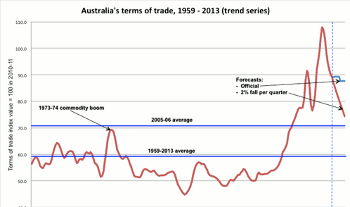The March quarter national accounts show Australia's terms of trade fell about 1% in trend terms compared with the December quarter. Are official terms of trade forecasts for 2012-13 to 2014-15 optimistic?
Historically, Australia's terms of trade peaks have been sharp: fast increases followed by fast declines. So far, this has been the case in the run-up to the mid-2011 peak and the subsequent decline (see Chart). The official forecasts out to 2014-15 imply the decline will suddenly slow markedly. Beyond 2014-15, this continues. The terms of trade are projected to decline by about 1.3% per annum over a 15-year period, finally settling at 2005-06 levels. This is still higher than the last peak during the 1973-74 commodity boom. Is this projection too slow and too little?

Advertisement
Sources: ABS, 2013-14 Budget Papers, Geoff Carmody & Associates estimates.
The 2013-14 Budget forecasts a fall in Australia's terms of trade of 7.5% in 2012-13. If the terms of trade in the June quarter equal the March quarter level, the 2012-13 decline would be around 10.75% (in trend terms). Assuming a 2% decline in the June quarter, the 2012-13 decline would be over 11%.
The Budget forecasts a terms of trade fall of only 0.75% in 2013-14. For this, and assuming the June quarter trend result equals the March quarter result, the terms of trade must increase above the March quarter level, on average, for every quarter in 2013-14.
From its trend peak in mid-2011, the average quarterly decline in the terms of trade has been 2.5%. Trend terms of trade declines averaging 2% in each of the next five quarters would result in a 7.3% decline in 2013-14. Continuing that assumption for 2014-15 would see the Budget forecast terms of trade decline of 1.75% revised down to 7.75%.
Such forecast revisions have big implications for our economy and Commonwealth Budget. If they reflect larger reductions in Australia's commodity export prices, forecast nominal GDP growth is affected. The Budget forecasts nominal GDP growth of 3.25%, 5% and 5%, respectively, in 2012-13, 2013-14 and 2014-15. Larger declines in the terms of trade could slash these forecasts, reducing or even eliminating the forecast gap between nominal and real GDP growth.
Using the Budget papers sensitivity analysis, such downgrades of the official terms of trade forecasts could wipe out any improvements in the underlying cash Budget deficit in coming years – or even reverse them.
Advertisement
Given falling terms of trade, why has the $A has remained at historically high (post-float) levels?
Of itself, a fall in the terms of trade implies nothing about the exchange rate.
Falling terms of trade mean our export prices in $A fall relative to import prices in $A. A depreciation of the $A means $A prices for our exports can increase (especially for contracts denominated in foreign currencies like the $US). But it also increases import prices measured in $A. The net effect on the ratio of export prices to import prices in $A – the terms of trade – is not clear.
In contrast, the exchange rate measures the value of one currency in terms of another.
The link between our terms of trade and the value of the $A comes through the balance of payments, both current and capital accounts. Other factors, such as global growth conditions, and not just commodity supply capacity for our major commodity exports, affect our balance of payments and demand for the $A.
Historically, weaker global growth, and increased global supply of our commodity exports, tended to result in falling terms of trade plus a lower $A. However, as long as Australia is perceived as a (relatively) well-managed economy, given emerging global 'currency wars', risk aversion and relatively disciplined monetary policy here could support the $A via strong net capital inflows.
Both falling terms of trade and a depreciating $A convey the same policy message.
Falling terms of trade mean the world is imposing cuts in our national income. Our recession in terms of real per capita net national disposable income has been running unbroken for 15 months now. Martin Ferguson noted we must grow our pie before we can distribute it. Our slices of pie, on average, are shrinking.
A depreciating $A is no 'free lunch' either. It can improve our international competitiveness. This requires export prices to fall in foreign currency terms (even if they rise in $A terms). Import prices must increase in $A terms. Local price effects of depreciation must not be allowed to flow on into higher wage and price inflation here. Real incomes must shaved, or at least grow less. Otherwise the competitive gains from depreciation won't last.
Falling terms of trade and a weaker $A are telling us it's well past time the policy switches are flipped more decisively from punchbowl to prudence and productivity.